Abstract
1 The voltage- and time-dependence of the depression of the maximum rate of depolarization (Vmax) by two steroidal anti-arrhythmic drugs, CCI22277 and Org 6001 were studied in guinea-pig ventricle. 2 At normal resting potentials CCI22277 (2 microM and 4 microM) produced very little depression of Vmax at very low driving rates (resting block) but trains of stimuli at interstimulus intervals (ISI) of less than 10,000 ms led to an exponential decline in Vmax to a new plateau over 100-200 beats. 3 This 'rate-dependent block' (RDB) increased with rate over the range ISI=4800 to ISI=200 ms. 4 Org 6001 30 microM and 60 microM produced a similar degree of RDB over the same range of frequencies but the new plateau level of Vmax was reached much more rapidly (20-30 beats) and there was a moderate degree of depression of Vmax in the resting tissue. 5 Recovery from RDB in the presence of both drugs was an exponential process with time constants (tau re) of 80.4 +/- 7.4 s for CCI22277 and 4.6 +/- 0.5 s for Org 6001. 6 Both drugs shifted the steady-state inactivation curve, relating Vmax to resting membrane potential, in the hyperpolarizing direction, implying selective depression of depolarized cells.
Full text
PDF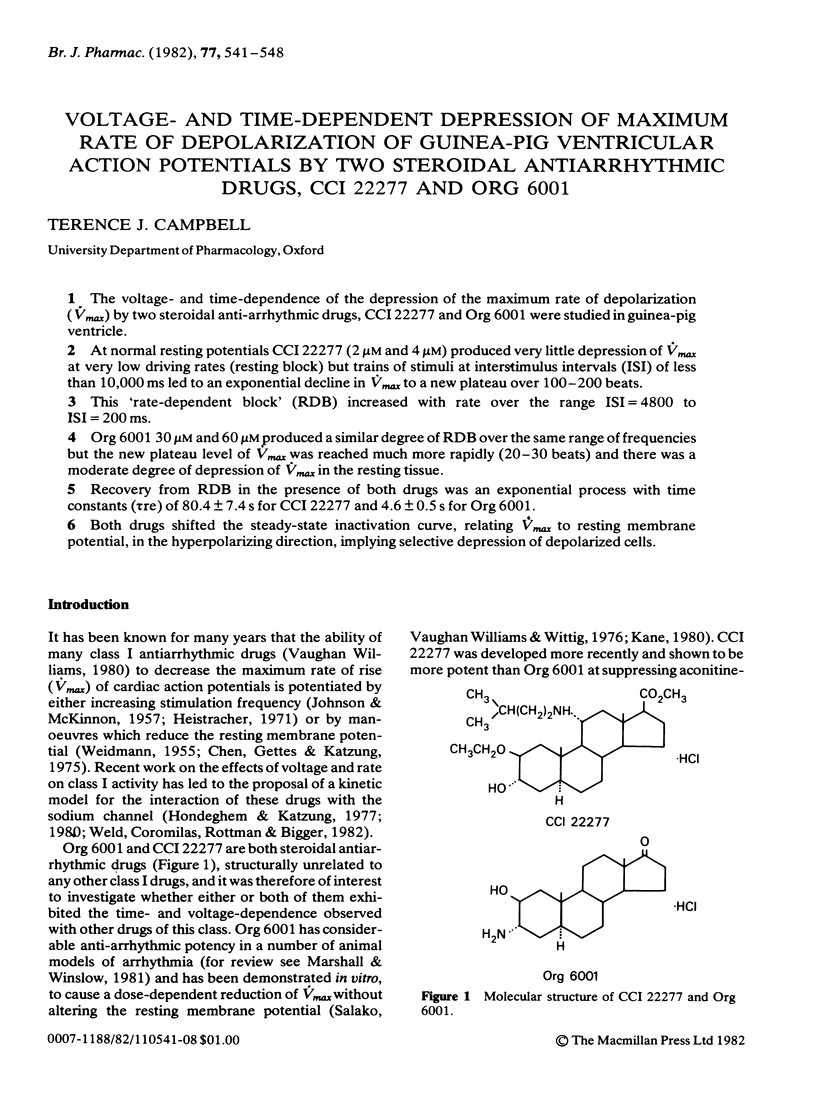
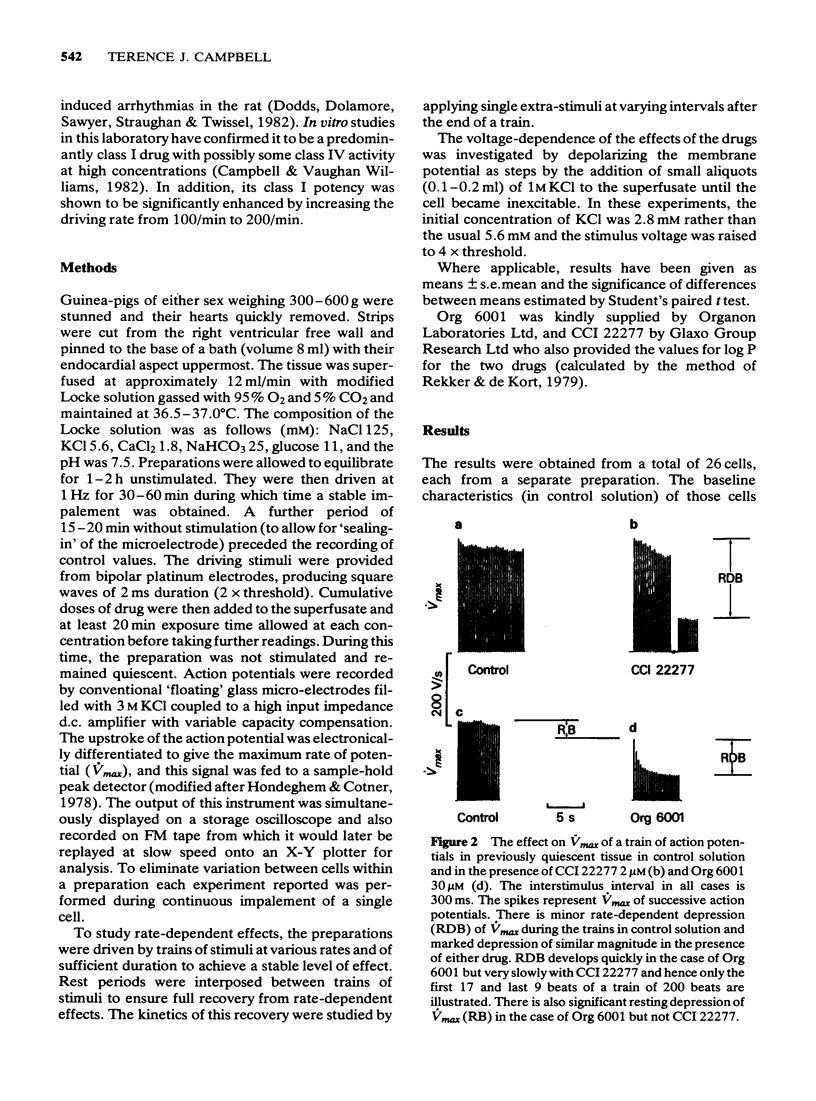
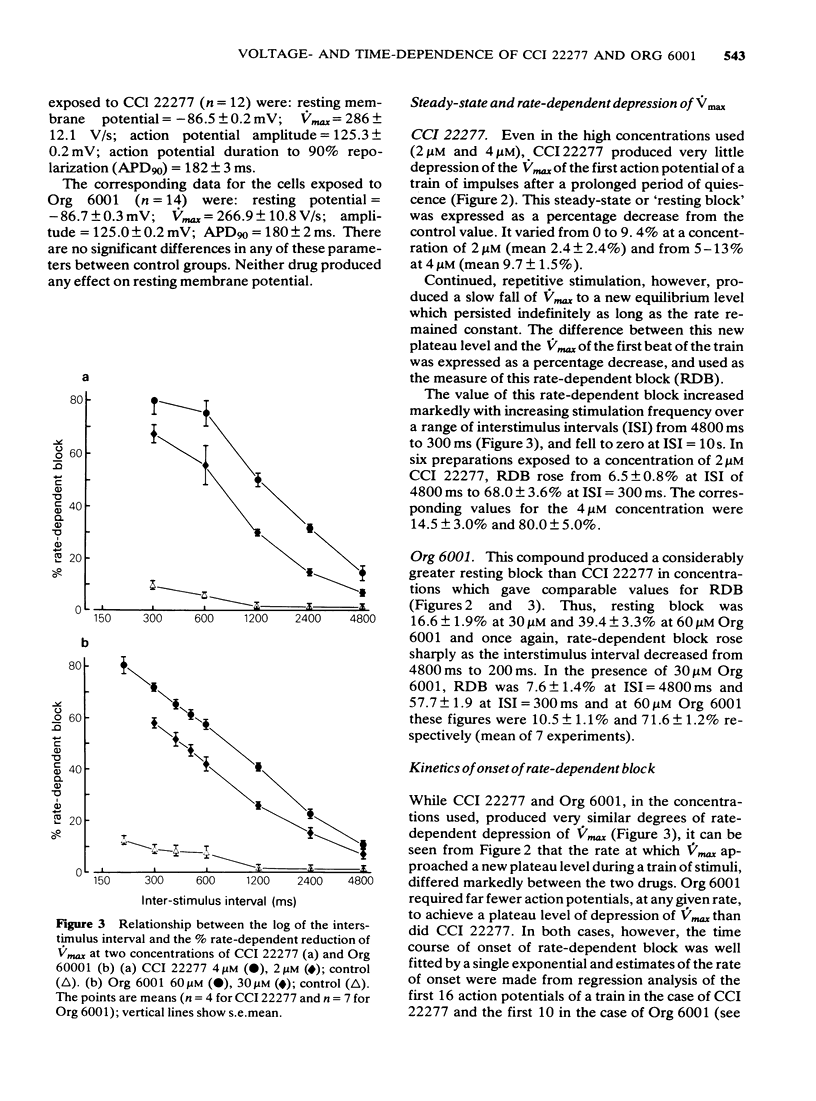
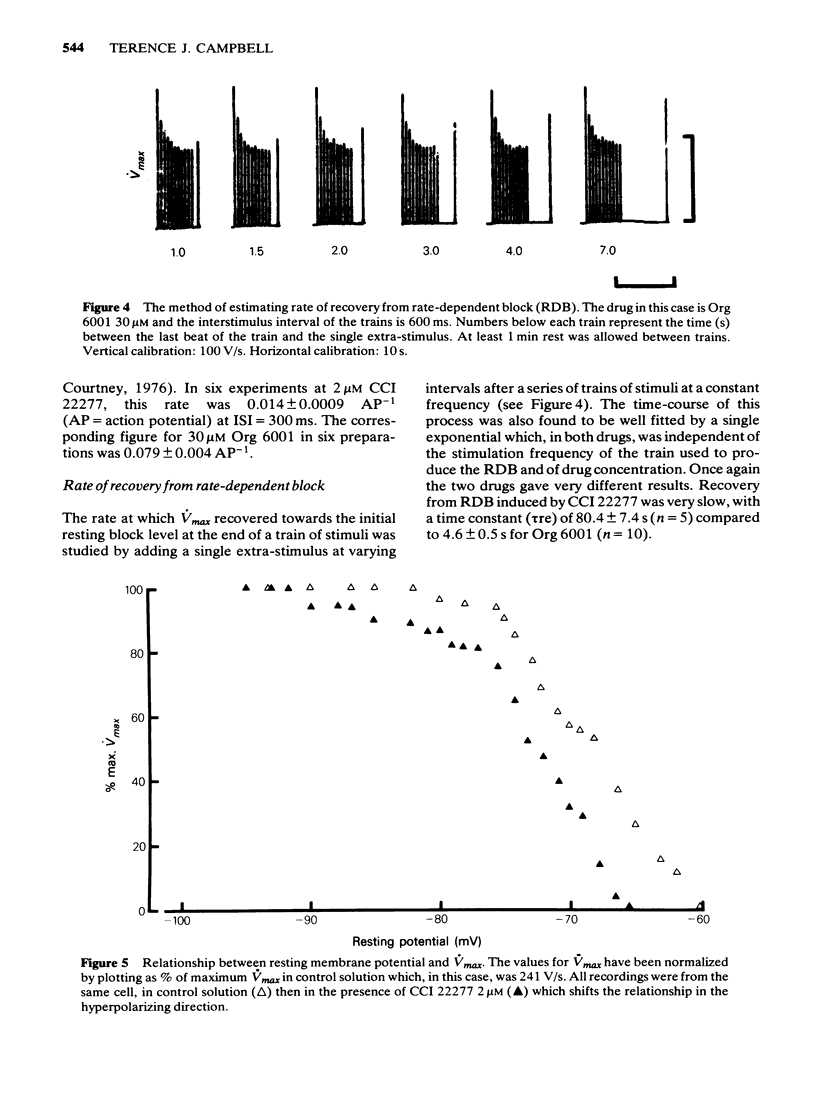
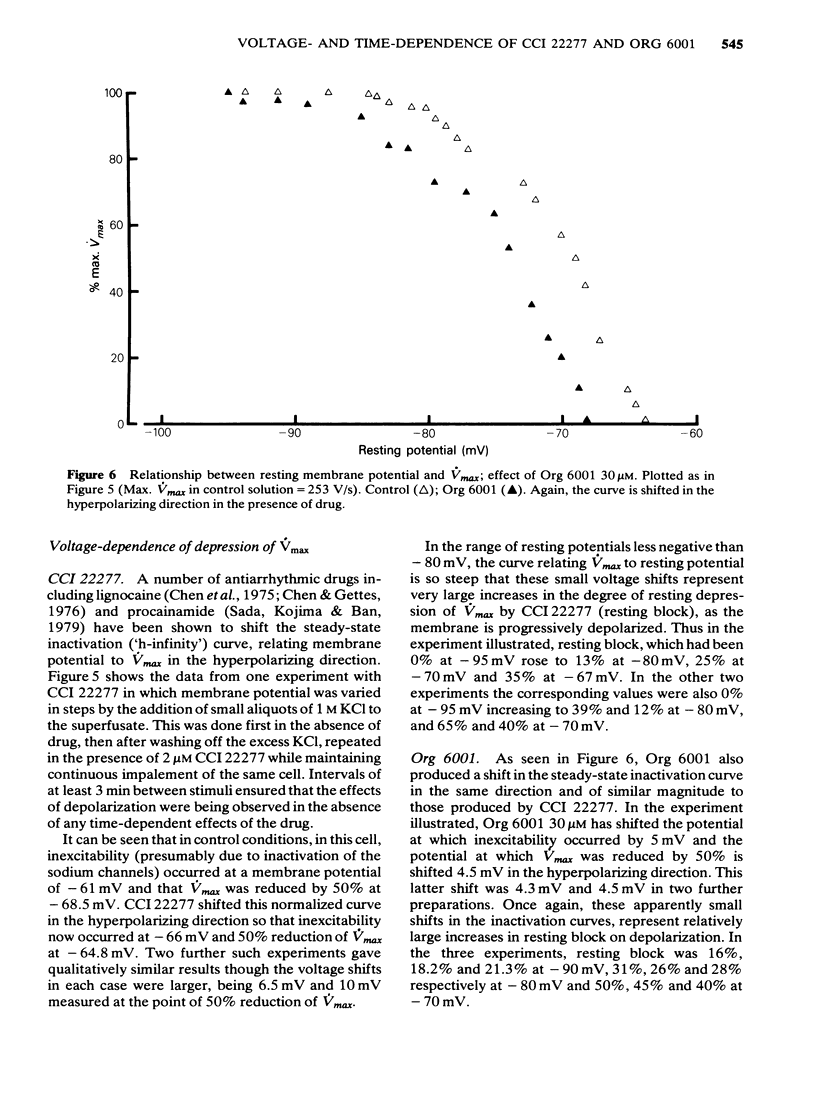
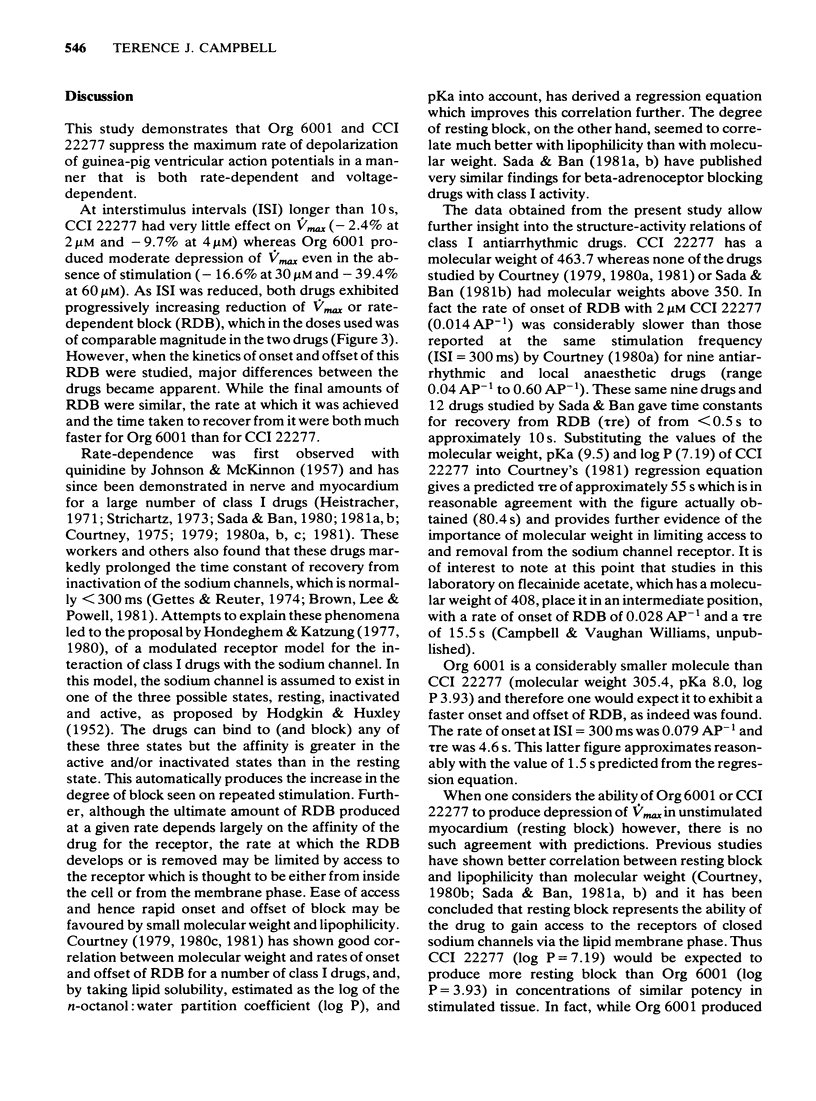
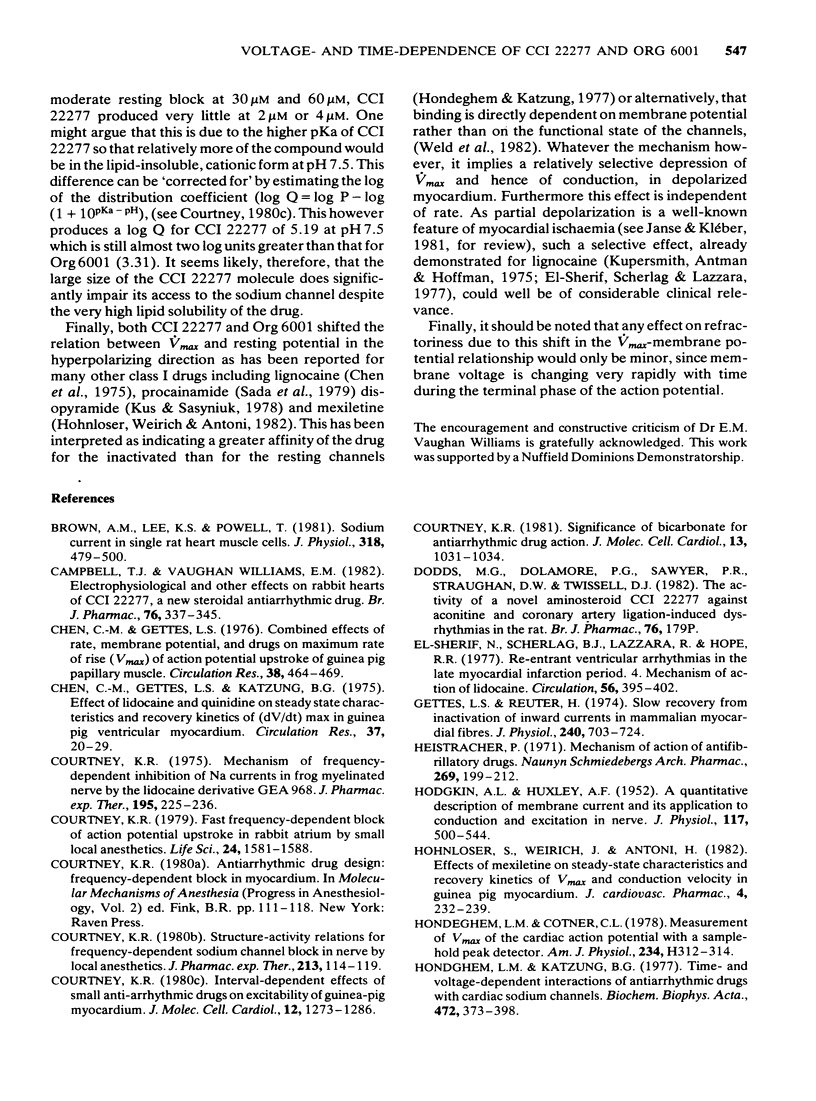
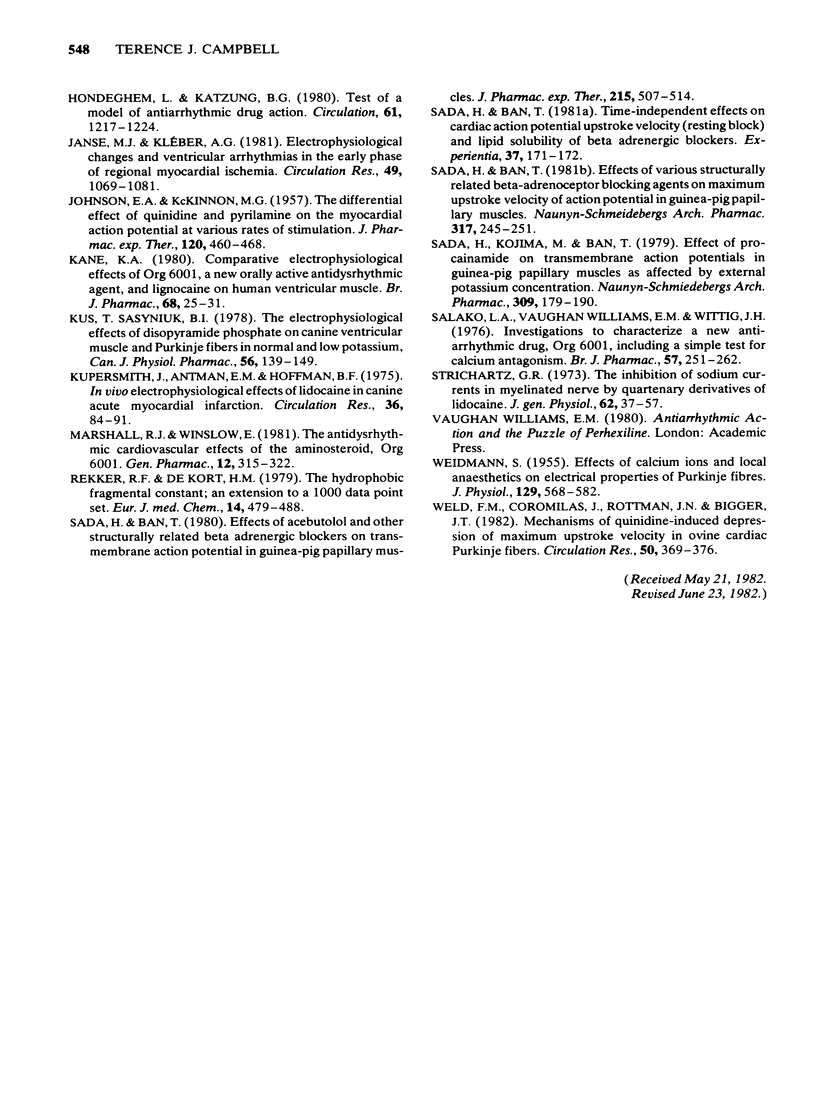
Selected References
These references are in PubMed. This may not be the complete list of references from this article.
- Brown A. M., Lee K. S., Powell T. Sodium current in single rat heart muscle cells. J Physiol. 1981 Sep;318:479–500. doi: 10.1113/jphysiol.1981.sp013879. [DOI] [PMC free article] [PubMed] [Google Scholar]
- Campbell T. J., Vaughan Williams E. M. Electrophysiological and other effects on rabbit hearts of CCI22277, a new steroidal antiarrhythmic drug. Br J Pharmacol. 1982 Jun;76(2):337–345. doi: 10.1111/j.1476-5381.1982.tb09225.x. [DOI] [PMC free article] [PubMed] [Google Scholar]
- Chen C. M., Gettes L. S., Katzung B. G. Effect of lidocaine and quinidine on steady-state characteristics and recovery kinetics of (dV/dt)max in guinea pig ventricular myocardium. Circ Res. 1975 Jul;37(1):20–29. doi: 10.1161/01.res.37.1.20. [DOI] [PubMed] [Google Scholar]
- Chen C., Gettes L. S. Combined effects of rate membrane potential, and drugs on maximum rate of rise (Vmax) of action potential upstroke of guinea pig papillary muscle. Circ Res. 1976 Jun;38(6):464–469. doi: 10.1161/01.res.38.6.464. [DOI] [PubMed] [Google Scholar]
- Courtney K. R. Fast frequency-dependent block of action potential upstroke in rabbit atrium by small local anesthetics. Life Sci. 1979 Apr 23;24(17):1581–1588. doi: 10.1016/0024-3205(79)90019-5. [DOI] [PubMed] [Google Scholar]
- Courtney K. R. Interval-dependent effects of small antiarrhythmic drugs on excitability of guinea-pig myocardium. J Mol Cell Cardiol. 1980 Nov;12(11):1273–1286. doi: 10.1016/0022-2828(80)90071-1. [DOI] [PubMed] [Google Scholar]
- Courtney K. R. Mechanism of frequency-dependent inhibition of sodium currents in frog myelinated nerve by the lidocaine derivative GEA. J Pharmacol Exp Ther. 1975 Nov;195(2):225–236. [PubMed] [Google Scholar]
- Courtney K. R. Significance of bicarbonate for antiarrhythmic drug action. J Mol Cell Cardiol. 1981 Nov;13(11):1031–1034. doi: 10.1016/0022-2828(81)90479-x. [DOI] [PubMed] [Google Scholar]
- Courtney K. R. Structure-activity relations for frequency-dependent sodium channel block in nerve by local anesthetics. J Pharmacol Exp Ther. 1980 Apr;213(1):114–119. [PubMed] [Google Scholar]
- El-Sherif N., Scherlag B. J., Lazzara R., Hope R. R. Re-entrant ventricular arrhythmias in the late myocardial infarction period. 4. Mechanism of action of lidocaine. Circulation. 1977 Sep;56(3):395–402. doi: 10.1161/01.cir.56.3.395. [DOI] [PubMed] [Google Scholar]
- Gettes L. S., Reuter H. Slow recovery from inactivation of inward currents in mammalian myocardial fibres. J Physiol. 1974 Aug;240(3):703–724. doi: 10.1113/jphysiol.1974.sp010630. [DOI] [PMC free article] [PubMed] [Google Scholar]
- HODGKIN A. L., HUXLEY A. F. A quantitative description of membrane current and its application to conduction and excitation in nerve. J Physiol. 1952 Aug;117(4):500–544. doi: 10.1113/jphysiol.1952.sp004764. [DOI] [PMC free article] [PubMed] [Google Scholar]
- Heistracher P. Mechanism of action of antifibrillatory drugs. Naunyn Schmiedebergs Arch Pharmakol. 1971;269(2):199–212. doi: 10.1007/BF01003037. [DOI] [PubMed] [Google Scholar]
- Hohnloser S., Weirich J., Antoni H. Effects of mexiletine on steady-state characteristics and recovery kinetics of V max and conduction velocity in guinea pig myocardium. J Cardiovasc Pharmacol. 1982 Mar-Apr;4(2):232–239. doi: 10.1097/00005344-198203000-00011. [DOI] [PubMed] [Google Scholar]
- Hondeghem L. M., Cotner C. L. Measurement of Vmax of the cardiac action potential with a sample/hold peak detector. Am J Physiol. 1978 Mar;234(3):H312–H314. doi: 10.1152/ajpheart.1978.234.3.H312. [DOI] [PubMed] [Google Scholar]
- Hondeghem L. M., Katzung B. G. Time- and voltage-dependent interactions of antiarrhythmic drugs with cardiac sodium channels. Biochim Biophys Acta. 1977 Nov 14;472(3-4):373–398. doi: 10.1016/0304-4157(77)90003-x. [DOI] [PubMed] [Google Scholar]
- Hondeghem L., Katzung B. G. Test of a model of antiarrhythmic drug action. Effects of quinidine and lidocaine on myocardial conduction. Circulation. 1980 Jun;61(6):1217–1224. doi: 10.1161/01.cir.61.6.1217. [DOI] [PubMed] [Google Scholar]
- JOHNSON E. A., McKINNON M. G. The differential effect of quinidine and pyrilamine on the myocardial action potential at various rates of stimulation. J Pharmacol Exp Ther. 1957 Aug;120(4):460–468. [PubMed] [Google Scholar]
- Janse M. J., Kléber A. G. Electrophysiological changes and ventricular arrhythmias in the early phase of regional myocardial ischemia. Circ Res. 1981 Nov;49(5):1069–1081. doi: 10.1161/01.res.49.5.1069. [DOI] [PubMed] [Google Scholar]
- Kane K. A. Comparative electrophysiological effects of Org 6001, a new orally active antidysrhythmic agent, and lignocaine on human ventricular muscle. Br J Pharmacol. 1980 Jan;68(1):25–31. doi: 10.1111/j.1476-5381.1980.tb10695.x. [DOI] [PMC free article] [PubMed] [Google Scholar]
- Kupersmith J., Antman E. M., Hoffman B. F. In vivo electrophysiological effects of lidocaine in canine acute myocardial infarction. Circ Res. 1975 Jan;36(1):84–91. doi: 10.1161/01.res.36.1.84. [DOI] [PubMed] [Google Scholar]
- Kus T., Sasyniuk B. I. The electrophysiological effects of disopyramide phosphate on canine ventricular muscle and Purkinje fibers in normal and low potassium. Can J Physiol Pharmacol. 1978 Feb;56(1):139–149. doi: 10.1139/y78-018. [DOI] [PubMed] [Google Scholar]
- Marshall R. J., Winslow E. The antidysrhythmic and cardiovascular effects of the aminosteroid, ORG 6001. Gen Pharmacol. 1981;12(5):315–322. doi: 10.1016/0306-3623(81)90082-3. [DOI] [PubMed] [Google Scholar]
- Sada H., Ban T. Effects of acebutolol and other structurally related beta adrenergic blockers on transmembrane action potential in guinea-pig papillary muscles. J Pharmacol Exp Ther. 1980 Nov;215(2):507–514. [PubMed] [Google Scholar]
- Sada H., Kojima M., Ban T. Effect of procainamide on transmembrane action potentials in guinea-pig papillary muscles as affected by external potassium concentration. Naunyn Schmiedebergs Arch Pharmacol. 1979 Nov;309(2):179–190. doi: 10.1007/BF00501227. [DOI] [PubMed] [Google Scholar]
- Salako L. A., Williams V., Wittig J. H. Investigations to characterize a new anti-arrhythmic drug, ORG 6001 including a simple test for calcium antagonism. Br J Pharmacol. 1976 Jun;57(2):251–262. doi: 10.1111/j.1476-5381.1976.tb07475.x. [DOI] [PMC free article] [PubMed] [Google Scholar]
- Strichartz G. R. The inhibition of sodium currents in myelinated nerve by quaternary derivatives of lidocaine. J Gen Physiol. 1973 Jul;62(1):37–57. doi: 10.1085/jgp.62.1.37. [DOI] [PMC free article] [PubMed] [Google Scholar]
- WEIDMANN S. Effects of calcium ions and local anesthetics on electrical properties of Purkinje fibres. J Physiol. 1955 Sep 28;129(3):568–582. doi: 10.1113/jphysiol.1955.sp005379. [DOI] [PMC free article] [PubMed] [Google Scholar]
- Weld F. M., Coromilas J., Rottman J. N., Bigger J. T., Jr Mechanisms of quinidine-induced depression of maximum upstroke velocity in ovine cardiac Purkinje fibers. Circ Res. 1982 Mar;50(3):369–376. doi: 10.1161/01.res.50.3.369. [DOI] [PubMed] [Google Scholar]


